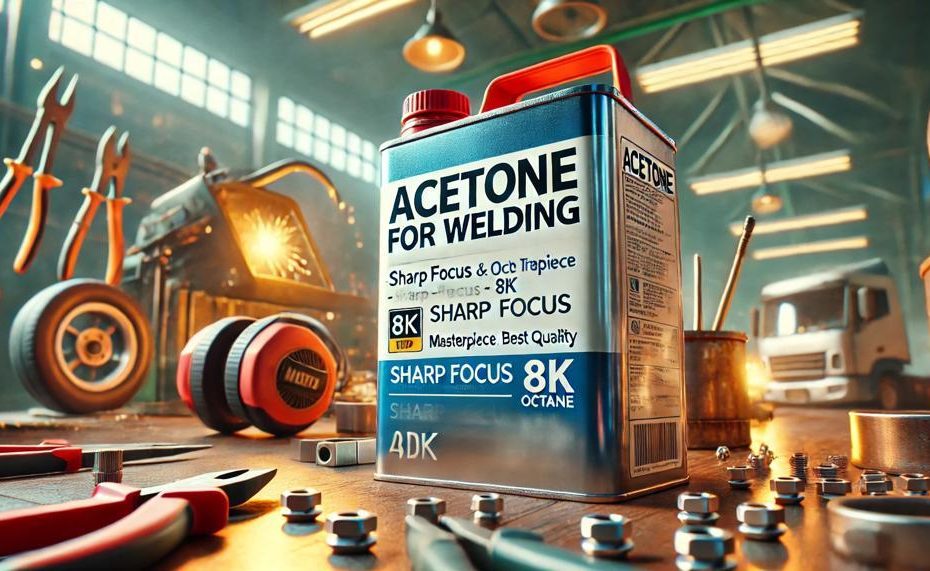In the ever-evolving world of metal fabrication, achieving that perfect weld is akin to an artist creating their masterpiece. Intricate details, best practices, and little-known secrets pave the way to excellence.
Among these secrets, one stands out due to its simplicity yet pivotal role in refining the welding process: acetone. This common chemical, often overshadowed by its more popular uses, holds the key to cleaner, stronger, and more reliable welds.
But how exactly does acetone contribute to the welding process? You’re about to embark on an enlightening journey that will demystify this question and transform the way you view this versatile solvent. Expect to dive into:
- The Science of Acetone: Understanding its chemical makeup and why it’s an ideal candidate for welding applications.
- A Cleaner Welding Surface: How acetone removes impurities that can compromise weld strength.
- Safety Best Practices: Ensuring safe handling and application to avoid potential hazards.
- Innovative Uses Beyond Cleaning: A look at other inventive ways acetone can assist welders.
- Real-World Applications: Insightful examples of acetone making a difference in welding projects.
Whether you’re a seasoned welder, a curious hobbyist, or somewhere in between, this article promises to enhance your knowledge and skills with a seemingly simple but profoundly impactful tool.
Let’s ignite our torches, don our safety gear, and unravel the wonders of using acetone in welding together.
Contents
- 1 Acetone For Welding Helps You To
- 2 Why Use Acetone For Welding Preparation?
- 3 Cleaning Mild Steel For Welding With Acetone
- 4 Cleaning Stainless Steel For Welding With Acetone
- 5 Before Welding Clean Aluminum With Acetone
- 6 Use Acetone On Your Filler Metal Rods
- 7 A Bit About Acetone In Welding
- 8 How To Use Acetone On Metal Before Welding
- 9 Sourcing Your Acetone For Your Welding Metal
- 10 Conclusion
Acetone For Welding Helps You To
Acetone, a powerful solvent renowned for its cleaning prowess, plays a pivotal role in the welding process, ensuring the creation of impeccable and durable welds. It offers a plethora of benefits for welders, streamlining their tasks while enhancing safety and efficiency. Below is a detailed breakdown of how acetone aids in the welding process and the numerous advantages it bestows upon welders:
| Function | Benefits | Safety Precautions |
| Cleaning Metal Surfaces | Removes oils, contaminants, and impurities, which enhances the quality of the weld. | Wear protective gloves and ensure proper ventilation to mitigate risks of skin irritation or respiratory issues. |
| Rapid Evaporation | Leaves no residue or film, crucial for tasks requiring high precision. | Maintain a well-ventilated area to prevent inhalation of fumes. |
| Tool Maintenance | Prevents rust and corrosion on welding tools, extending their lifespan and saving costs on replacements. | Store acetone in a cool, dry place away from open flames due to its high flammability. |
| Improving Adhesion | Enhances adhesion between welded surfaces, reducing the likelihood of defects and failures. | Always use acetone in controlled quantities to avoid unnecessary exposure. |
| Cleaning Filler Rods | Ensures clean metal filler rods for TIG welding, contributing to stronger and cleaner welds. | Avoid substituting acetone with products containing moisturizers or additives that can compromise weld integrity. |
Acetone’s efficacy as a degreaser is particularly beneficial for MIG and TIG welding, where the cleanliness of the metal significantly impacts the final weld quality. Its ability to swiftly remove oil, grease, and other surface impurities from various metals—including mild or low carbon steel, stainless steel, and aluminum—without leaving chemical residues makes it an indispensable tool in a welder’s arsenal.
Moreover, its convenience extends beyond just preparation. Post-welding cleanup is simplified with acetone’s ability to effectively clean up spills and remove adhesives or other materials from metal surfaces. This versatility not only ensures a tidy workspace but also contributes to safer welding environments by reducing potential hazards associated with leftover contaminants.
However, despite its myriad benefits, the handling of acetone demands respect for its potential hazards.
Why Use Acetone For Welding Preparation?

The use of acetone in welding preparation is akin to setting the stage for a flawless performance. It’s the unsung hero that ensures the metal’s surface is pristine, allowing the weld to adhere without a hitch. Here’s how acetone sweeps the stage clean for a stellar welding show:
| Removal of Contaminants | Acetone excels in stripping away undesirables like oil, grease, and dirt from metals such as mild or low carbon steel, stainless steel, and aluminum. This cleansing ritual ensures that the metal surfaces are in their prime state for welding. |
| Evaporation Rate | Its quick evaporation rate is a boon, leaving behind no chemical residue to tarnish the metal’s surface. This characteristic makes it a preferred choice for welders who value both efficiency and cleanliness. |
| Compatibility with Welding Types | While certain welding types might forgive a bit of grime, MIG or TIG welding demands the utmost purity. Acetone’s ability to purify without prejudice makes it indispensable for achieving high-quality welds across various welding techniques. |
In essence, acetone acts as the gatekeeper of quality in welding preparation. By banishing impurities, ensuring a residue-free surface, and catering to the needs of different welding methods, it significantly contributes to the overall effectiveness of welding preparation.
Its role cannot be overstated; a clean start with acetone can mean the difference between a weld that holds strong and one that falters under pressure.
Cleaning Mild Steel For Welding With Acetone
Absolutely, acetone can be used to effectively clean mild steel before welding. This solvent is a powerhouse when it comes to preparing your metal for welding, ensuring that oil, grease, and other impurities don’t stand a chance.
Its quick evaporation rate means it won’t leave any unwelcome residue that could interfere with the welding process. Not only does it prep your mild steel for a stronger weld, but it also helps in achieving a cleaner, more professional finish. Here’s a breakdown of why acetone is your go-to cleaner for mild steel welding:
| Property | Benefit | Application in Welding |
| Degreasing Capability | Removes oil and grease | Ensures clean surface for welding |
| Rapid Evaporation | Leaves no residue | Prevents contamination of the weld area |
| Effectiveness on Mild Steel | Compatible with commonly welded material | Universal cleaning solution for various projects |
For those dabbling in welding, whether it be MIG or TIG, starting off with a surface cleaned with acetone can significantly uplift the quality of your welds. Remember, a clean start is half the battle won.
Before diving into the process, make sure you don the necessary safety gear – gloves and goggles are non-negotiables here. Acetone’s strong degreasing properties are unmatched, but they come with the need for careful handling due to its flammable nature.
Cleaning Stainless Steel For Welding With Acetone
The best method for cleaning stainless steel before welding with acetone involves a straightforward yet meticulous process to ensure that the surface is pristine, enhancing the quality of the weld. Here’s a step-by-step guide encapsulated in a table format for clarity:
| Step | Action | Details |
| 1 | Gather Supplies | Acquire acetone, clean rags or towels, and a stainless-steel appropriate wire brush. |
| 2 | Apply Acetone | Using a clean rag, liberally apply acetone onto the stainless steel surface, ensuring complete coverage. |
| 3 | Let It Sit | Allow the acetone to rest on the surface for a few minutes to break down oils and greases. |
| 4 | Scrub | Gently scrub the surface with the wire brush in circular motions to dislodge stubborn contaminants. |
| 5 | Wipe Clean | With a fresh rag, meticulously wipe off the dissolved contaminants and excess acetone. Repeat with new rags until completely clean. |
| 6 | Final Inspection | Closely examine the surface for any remaining impurities; repeat cleaning if necessary until spotless. |
This process leverages acetone’s potent degreasing properties to dissolve and eliminate contaminants from the stainless steel surface effectively. The use of clean rags throughout is crucial to prevent recontamination, and gentle scrubbing ensures the integrity of the material is maintained. Finally, thorough inspection guarantees a contaminant-free surface, ready for high-quality welding.
Remember, while acetone is highly effective and cost-efficient, it’s also flammable. Therefore, handling it with care in a well-ventilated area away from any ignition sources is paramount.
Before Welding Clean Aluminum With Acetone
Cleaning aluminum with acetone before welding is paramount for several pivotal reasons, intricately linked to the integrity and quality of the weld. Aluminum, known for its lightweight and robust nature, is susceptible to contamination from oils, greases, and moisture, which can significantly impede the welding process.
Acetone acts as a potent degreaser, meticulously removing these contaminants to ensure a clean joining surface. This preparation step is not just a recommendation; it’s a cornerstone for achieving top-tier welds.
| Reason | Explanation | Benefit |
| Removal of Contaminants | Acetone dissolves oils, greases, and residues. | Promotes strong adhesion and fusion of metal surfaces. |
| Prevention of Oxidation | Cleansing with acetone prevents water vapor-related oxidation. | Minimizes corrosion and material degradation over time. |
| Enhanced Weld Integrity | A clean surface ensures uniform heat distribution during welding. | Results in durable, high-quality welds with fewer defects. |
The application of acetone serves not merely as a cleaning step but as an essential prelude to the welding journey. By eradicating potential barriers to effective welding, acetone ensures that the aluminum’s surface is primed and ready, setting the stage for a seamless melding process. The implications of skipping this crucial step can range from compromised weld strength to increased susceptibility to corrosion — pitfalls that are easily avoidable with a bit of prep work.
In essence, the role of acetone in pre-welding preparation transcends mere cleanliness; it’s about laying a robust foundation for the welding narrative to unfold. This simple action fortifies the aluminum against the elements and readies it for the intense process of becoming part of something greater.
Use Acetone On Your Filler Metal Rods
Using acetone on your filler metal rods before welding is like giving your weld a clean canvas, ensuring that the fusion between the metals is strong, clean, and aesthetically pleasing. This step is paramount across various types of metals such as mild or low carbon steel, stainless steel, and aluminum, each benefiting uniquely from this preparation process.
| Metal Type | Impact of Using Acetone | Reason for Effectiveness |
|---|---|---|
| Mild/Low Carbon Steel | Enhances weld quality | Removes oils and contaminants that could cause poor arc stability. |
| Stainless Steel | Prevents porosity and inclusions | Cleanses the surface, ensuring a contaminant-free weld zone. |
| Aluminum | Reduces oxidation risk | Eliminates moisture and oils, preventing oxidation during welding. |
For MIG or TIG welding, where precision and cleanliness are paramount, using acetone not only ensures that the filler metal rods are free of any impurities but also guards against common welding issues like porosity or inclusions. In stick or flux core welding, while it might not be as critical, it still plays a significant role in achieving a superior weld quality.
Acetone evaporates quickly and leaves no residue, which means it won’t introduce any foreign substances that could interfere with the welding process. However, it’s not just about the cleanliness; safety is another crucial aspect. Given its flammable nature, it’s vital to use acetone in a well-ventilated area away from any ignition sources.
In essence, swabbing your filler metal rods with acetone before getting down to the nitty-gritty of welding can drastically improve your outcomes. It’s a simple step that packs a punch—ensuring your welds are not only structurally sound but also look the part.
A Bit About Acetone In Welding
Acetone plays a pivotal role in the welding realm, acting as a linchpin for ensuring the integrity and aesthetics of welds. Its utility stretches from being a robust cleaner to a preventive agent against corrosion, making it indispensable for welders aiming for precision and durability in their work.
Role of Acetone in Welding
- Surface Preparation: Acetone’s foremost role is preparing the metal surfaces for welding. It eradicates greases, oils, and unwelcome residues with an efficiency that’s hard to match. This leaves the metal surface in an immaculate state, ready for welding without any impurities that could compromise the weld’s quality.
- Corrosion Prevention: Beyond cleaning, acetone acts as a guardian against rust and corrosion on both the welding equipment and the metals being welded. This not only extends the lifespan of the equipment but also ensures that the metal surfaces remain pristine over time.
- Enhanced Weld Quality: By removing surface contaminants, acetone allows for better adhesion between welded surfaces. This translates into stronger, more resilient welds that are less prone to defects like porosity or lack of fusion.
- Safety Measures: While acetone is a boon for welders, it demands respect and caution in its handling due to its highly flammable nature and potential health hazards if mishandled.
Impact on Weld Quality
Utilising acetone in the welding process has a direct positive impact on weld quality:
- Stronger Welds: Clean surfaces ensure optimal fusion between metals, resulting in robust and durable welds.
- Aesthetic Appeal: Cleaner surfaces lead to smoother, more visually appealing welds without unnecessary spatter or defects.
- Reduced Defects: The likelihood of encountering welding defects is significantly diminished, thanks to the thorough cleaning action of acetone.
Safety Precautions
When handling acetone, it’s paramount to adhere to safety guidelines to mitigate risks:
- Use in well-ventilated areas to avoid inhalation.
- Wear appropriate personal protective equipment (PPE), such as gloves and goggles.
- Store away from heat sources due to its flammable nature.
How To Use Acetone On Metal Before Welding
To ensure the highest quality weld, it’s critical to prepare the metal surface properly using acetone. Below is a straightforward guide on how to execute this process efficiently:
| Step | Action | Important Notes |
| 1. | Clean with soap and water | Removes initial dirt and debris. Essential for a clean starting surface. |
| 2. | Rinse and dry | Eliminates soap residue, ensuring the metal is completely dry before proceeding. |
| 3. | Apply acetone | Use a clean cloth soaked in a modest amount of acetone for application. |
| 4. | Wipe down the surface | Cover the entire area to be welded, ensuring uniform cleaning. |
| 5. | Let it evaporate | Acetone must evaporate fully before welding begins; this usually happens swiftly. |
| 6. | Repeat if needed | For areas heavily soiled, a second round may be necessary for optimal cleanliness. |
| 7. | Safety precautions | Always wear protective gloves and ensure good ventilation. Mindful of acetone’s flammability and potential skin/eye irritation risks. |
By adhering to these steps, you’ll remove oils, grease, and any contaminants that could compromise your welding work.
Acetone’s quick-evaporating nature means that once it’s dried off, you can proceed with welding without worrying about chemical residues affecting the weld quality.
Sourcing Your Acetone For Your Welding Metal
Sourcing Your Acetone For Your Welding Metal requires a meticulous approach, focusing on both the quality and cost-effectiveness of the product. Acetone is indispensable in the welding process, ensuring metal surfaces are impeccably clean and free from contaminants that could jeopardize the integrity of the weld. Here, we explore various avenues for procuring acetone and key considerations to keep in mind.
Different Sources for Acetone
Local Hardware Stores
- Pros: Immediate availability, no shipping costs.
- Cons: Possibly higher prices, limited quantity options.
Online Retailers
- Pros: Competitive pricing, bulk purchase options.
- Cons: Delivery times, shipping fees for smaller orders.
Industrial Suppliers
- Pros: Bulk purchasing, specialized products.
- Cons: Minimum order requirements, business account might be necessary.
Chemical Supply Companies
- Pros: High purity acetone, knowledgeable staff.
- Cons: Higher prices, stringent purchasing protocols.
Factors When Choosing a Supplier
| Factor | Description | Why It Matters |
| Price | Cost per unit or bulk. | Impacts overall project budget. |
| Quantity | Available in desired amounts. | Suits project scale without excess. |
| Purity | Concentration of acetone. | Affects cleaning efficiency and weld quality. |
| Safety Information | Handling and storage guidelines. | Ensures safe use and compliance with regulations. |
| Delivery Time | Time taken for order to arrive. | Affects project timelines. |
Conclusion
Here’s the end of our look at acetone’s important role in welding. It’s clear that this flexible solvent is not just a backroom hand in the metal production theater; it’s also a major actor in its own right. Acetone’s strong cleaning power and fast discharge rate set the stage for a perfect performance, letting welders shape their metal works into works of art that are accurate and last a long time.
The trip through the world of acetone has shown how important it is for making welds smoother and stronger. As the unseen hero who works quietly behind the scenes to improve welding skills, acetone does everything from carefully cleaning metal surfaces to removing contaminants and making sure the integrity of filler rods. Its ability to improve bonding and stop rust makes it even more important for making welds that are both physically sound and nice to look at.
You should be careful and respectful when using acetone, though, as you would with any strong tool. It’s important to stress safety enough; wearing protection gear and following best practices will keep this chemical friend a help instead of a hindrance.
Adding acetone to your welding skills is like fine-tuning your instrument before a concert—it’s necessary for the materials and the work to work together in rhythm. As you use your torch with skill and knowledge, let acetone be your expert helper that turns your work from simple building into a strong and beautiful heritage that will last for generations. Welding isn’t just putting metals together; it’s also about making links that last. Tools like acetone make this easier by making sure that each fusion is done on a clean surface.





